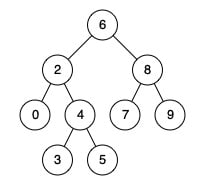Leetcode 235. How To Find a Nearest Common Ancestor In a Binary Search Tree
This email edition discusses finding the Lowest Common Ancestor in a Binary Search Tree using recursion.
Problem statement
Given a binary search tree (BST), find the lowest common ancestor (LCA) node of two given nodes in the BST.
According to the definition of LCA on Wikipedia: "The lowest common ancestor is defined between two nodes p and q as the lowest node in T that has both p and q as descendants (where we allow a node to be a descendant of itself)."
Example 1

Input: root = [6,2,8,0,4,7,9,null,null,3,5], p = 2, q = 8
Output: 6
Explanation: The LCA of nodes 2 and 8 is 6.
Example 2

Input: root = [6,2,8,0,4,7,9,null,null,3,5], p = 2, q = 4
Output: 2
Explanation: The LCA of nodes 2 and 4 is 2, since a node can be a descendant of itself according to the LCA definition.
Example 3
Input: root = [2,1], p = 2, q = 1
Output: 2
Constraints
- The number of nodes in the tree is in the range
[2, 10^5]. -10^9 <= Node.val <= 10^9.- All
Node.valare unique. p != q.pandqwill exist in the BST.
Solution: Recursion
Note that in a BST, the values of a node and its children left and right satisfy
left.value < node.value < right.value.
It lets you know which branch (left or right) of the root the nodes p and q belong to.
Code
#include <iostream>
using namespace std;
struct TreeNode {
int val;
TreeNode *left;
TreeNode *right;
TreeNode(int x) : val(x), left(nullptr), right(nullptr) {}
};
TreeNode* lowestCommonAncestor(TreeNode* root, TreeNode* p, TreeNode* q) {
if (p->val < root->val && q->val < root->val) {
return lowestCommonAncestor(root->left, p, q);
} else if (root->val < p->val && root->val < q->val) {
return lowestCommonAncestor(root->right, p, q);
}
return root;
}
int main() {
TreeNode zero(0);
TreeNode three(3);
TreeNode five(5);
TreeNode four(4);
four.left = &three;
four.right = &five;
TreeNode two(2);
two.left = &zero;
two.right = &four;
TreeNode seven(7);
TreeNode nine(9);
TreeNode eight(8);
eight.left = &seven;
eight.right = &nine;
TreeNode six(6);
six.left = &two;
six.right = &eight;
cout << lowestCommonAncestor(&six, &two, &eight)->val << endl;
cout << lowestCommonAncestor(&six, &two, &four)->val << endl;
cout << lowestCommonAncestor(&two, &two, &zero)->val << endl;
}
Output:
6
2
2
Code explanation
- The function takes three arguments:
root,p, andq.rootrepresents the root node of the BST, whilepandqrepresent the two nodes for which we want to find the lowest common ancestor. - The code starts with a recursive approach and a divide-and-conquer strategy. It checks whether the values of
pandqare less than the value of the currentrootnode or greater than the value of the currentrootnode. These comparisons are made using the values stored inp->val,q->val, androot->val. - If both
pandqare less thanroot->val, it means that both nodespandqare in the left subtree of the currentroot. In this case, the code recursively callslowestCommonAncestor(root->left, p, q)to search for the LCA in the left subtree. - If both
pandqare greater thanroot->val, it means that both nodespandqare in the right subtree of the currentroot. In this case, the code recursively callslowestCommonAncestor(root->right, p, q)to search for the LCA in the right subtree. - If neither of the above conditions is met, it means that one node is in the left subtree, and the other is in the right subtree, or one of them is the current
rootnode itself. In either case, the currentrootnode is the lowest common ancestor, and the code returnsroot. - The recursion continues until it finds the LCA or reaches a null node (indicating that one of the nodes
porqwas not found in the subtree). In the latter case, the code returnsroot, which might be a valid LCA if one of the nodes is present in the subtree ornullptrif both nodes are not in the tree.
Complexity
This solution leverages the properties of a BST, where the left subtree contains nodes with values less than the root, and the right subtree contains nodes with values greater than the root, to efficiently find the lowest common ancestor of two nodes p and q.
- Runtime:
O(h), wherehis the height of the tree. In a balanced BST, this height is typicallylog(N)forNnodes. - Extra space:
O(1).